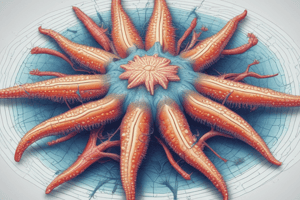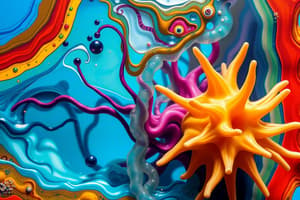Podcast
Questions and Answers
What is another name for the water vascular system in sea stars?
What is another name for the water vascular system in sea stars?
- Gastrovascular system
- Amphibious network
- Aquatic circulatory system
- Ambulacral system (correct)
Which of the following is NOT a function of the water vascular system?
Which of the following is NOT a function of the water vascular system?
- Digestion (correct)
- Respiration
- Locomotion
- Food capturing
Which structure is directly responsible for the entry of water into the water vascular system?
Which structure is directly responsible for the entry of water into the water vascular system?
- Stone canal
- Tube feet
- Ring canal
- Madreporite (correct)
What type of structure supports the walls of the stone canal?
What type of structure supports the walls of the stone canal?
Which of the following structures is believed to have a lymphatic function in the water vascular system?
Which of the following structures is believed to have a lymphatic function in the water vascular system?
What shape does the ring canal typically have?
What shape does the ring canal typically have?
What do polian vesicles primarily serve as in the water vascular system?
What do polian vesicles primarily serve as in the water vascular system?
Which of the following correctly describes the madreporite's location?
Which of the following correctly describes the madreporite's location?
What is the primary function of the lateral canals in the ambulacral system?
What is the primary function of the lateral canals in the ambulacral system?
Which part of the tube foot is responsible for attachment to the substratum?
Which part of the tube foot is responsible for attachment to the substratum?
How does an Asterias achieve locomotion on a horizontal surface?
How does an Asterias achieve locomotion on a horizontal surface?
What mechanism allows the tube feet to extend when moving?
What mechanism allows the tube feet to extend when moving?
In what direction does the radial water canal run within the arm?
In what direction does the radial water canal run within the arm?
What sequential action follows the attachment of the tube feet to the substratum?
What sequential action follows the attachment of the tube feet to the substratum?
Which structure acts like a valve in the lateral canals?
Which structure acts like a valve in the lateral canals?
What aids in the attachment of the tube feet to surfaces aside from suction?
What aids in the attachment of the tube feet to surfaces aside from suction?
Flashcards
Water vascular system
Water vascular system
A network of fluid-filled canals in sea stars, responsible for movement, feeding, and respiration.
Madreporite
Madreporite
The main opening of the water vascular system, located on the aboral surface of the sea star.
Stone canal
Stone canal
A tube that connects the madreporite to the ring canal, transporting water into the system.
Ring canal
Ring canal
Signup and view all the flashcards
Radial canals
Radial canals
Signup and view all the flashcards
Tiedemann's bodies
Tiedemann's bodies
Signup and view all the flashcards
Polian vesicles
Polian vesicles
Signup and view all the flashcards
Tube feet
Tube feet
Signup and view all the flashcards
Lateral Canals
Lateral Canals
Signup and view all the flashcards
Tube Feet (Podia)
Tube Feet (Podia)
Signup and view all the flashcards
Ampulla
Ampulla
Signup and view all the flashcards
Podium
Podium
Signup and view all the flashcards
Sucker
Sucker
Signup and view all the flashcards
Locomotion in Starfish
Locomotion in Starfish
Signup and view all the flashcards
Study Notes
Water Vascular System of Sea Star
- The water vascular system is a modified part of the coelom.
- It's a system of sea water-filled canals with specific corpuscles.
- It's also called the ambulacral system.
- Functions include locomotion, capturing food, and respiration.
Essential Parts of the Water Vascular System
- Madreporite: A rounded calcareous plate on the aboral surface of the central disc. It has radiating grooves and pores. The pores lead into canals that collect water.
- Stone canal: Connects the madreporite to the ring canal. It's lined with tall flagellated cells.
- Ring canal: A ring located inside the peristomial ring of ossicles, above the hypo-neural ring sinus.
- Radial canal: Extend from the ring canal into each arm.
- Tiedemann's bodies: Small yellowish, irregular or rounded bodies, inter-radially, from the ring canal, possibly lymphatic glands.
- Polian vesicles: Pear-shaped bladders connected to the ring canal, regulating pressure and producing amoeboid cells.
- Lateral canals: Short, narrow branches extending from the radial canals, connected to tube feet.
- Tube feet: Hollow, elastic, thin-walled structures with an ampulla, a podium, and a sucker. They are the primary means of locomotion, respiration, sensing, and capturing food.
Detailed Descriptions of Key Components
- Madreporite (i): Its surface has wavy grooves or furrows containing minute pores, leading to canals uniting to form collecting canals. These canals open to an ampulla.
- Stone canal (ii): The ampulla opens into an S-shaped stone canal, descending to the ring canal, and lined with tall flagellated cells. In adult Asterias, it contains ridges with spirally rolled lamellae.
- Ring canal (iii): Located inner side of the peristomial ring and above the hypo-neural ring sinus, its shape is pentagonal
- Tiedemann's Bodies (iv): Inter-radially located small, yellowish glandular bodies, attached to the peristomial ring ossicles; they are hypothesized to create amoeboid cells for the system.
Additional Components
- Polian vesicles (v): Situated within the inter-radial area of the ring canal, little pear-like, thin-walled, and contractile bladders
- Radial canals (vi): Extend throughout each arm from the ring canal, terminating at the terminal tentacle, running immediately to the oral side of the ambulacral muscles.
- Lateral canals (vii): short branches extending from the radial canals, attached to tube feet. They possess a valve preventing backward water flow. tube feet connected to lateral canals.
Tube Feet (viii)
- Tube feet are found in four rows in each ambulacral groove within each arm.
- They're thin-walled, closed-cylinder structures with an upper sac-like ampulla, a middle podium, and a lower disc-like sucker.
- Their purpose is primarily locomotion, respiration, sensing, and food capture.
Locomotion on a Horizontal Surface
- An Asterias moves by contracting the ampullae, forcing water into the podia, extending the tube feet.
- Podia attach to the substrate and the muscles contract, moving the animal. This process is repeated for further movement.
Studying That Suits You
Use AI to generate personalized quizzes and flashcards to suit your learning preferences.




